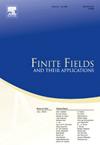椭圆曲线上的等对偶MDS码
IF 1.2
3区 数学
Q1 MATHEMATICS
引用次数: 0
摘要
对于有限域上的线性码C,如果它的对偶码C⊥等于它本身,那么这个码C就被称为等距对偶。本文首先证实了Han和Ren提出的关于等距对偶MDS椭圆码的一个猜想。随后,给出了椭圆曲线上的两种等距-对偶最大距离可分离码的构造。当q为偶数时,新码长n满足n≤q+⌊2q⌋−12;当q为奇数时,新码长n满足n≤q+⌊2q⌋−32。此外,我们还考虑了两种结构的船体尺寸。在偶特征有限域的情况下,等距对偶MDS码等价于自对偶MDS码和线性互补对偶MDS码。最后,我们将我们的结果应用于纠缠辅助量子纠错码(EAQECCs),并获得了两个新的MDS EAQECCs家族。本文章由计算机程序翻译,如有差异,请以英文原文为准。
On iso-dual MDS codes from elliptic curves
For a linear code C over a finite field, if its dual code is equivalent to itself, then the code C is said to be isometry-dual. In this paper, we first confirm a conjecture about the isometry-dual MDS elliptic codes proposed by Han and Ren. Subsequently, two constructions of isometry-dual maximum distance separable (MDS) codes from elliptic curves are presented. The new code length n satisfies when q is even and when q is odd. Additionally, we consider the hull dimension of both constructions. In the case of finite fields with even characteristics, an isometry-dual MDS code is equivalent to a self-dual MDS code and a linear complementary dual MDS code. Finally, we apply our results to entanglement-assisted quantum error correcting codes (EAQECCs) and obtain two new families of MDS EAQECCs.
求助全文
通过发布文献求助,成功后即可免费获取论文全文。
去求助
来源期刊
CiteScore
2.00
自引率
20.00%
发文量
133
审稿时长
6-12 weeks
期刊介绍:
Finite Fields and Their Applications is a peer-reviewed technical journal publishing papers in finite field theory as well as in applications of finite fields. As a result of applications in a wide variety of areas, finite fields are increasingly important in several areas of mathematics, including linear and abstract algebra, number theory and algebraic geometry, as well as in computer science, statistics, information theory, and engineering.
For cohesion, and because so many applications rely on various theoretical properties of finite fields, it is essential that there be a core of high-quality papers on theoretical aspects. In addition, since much of the vitality of the area comes from computational problems, the journal publishes papers on computational aspects of finite fields as well as on algorithms and complexity of finite field-related methods.
The journal also publishes papers in various applications including, but not limited to, algebraic coding theory, cryptology, combinatorial design theory, pseudorandom number generation, and linear recurring sequences. There are other areas of application to be included, but the important point is that finite fields play a nontrivial role in the theory, application, or algorithm.

 求助内容:
求助内容: 应助结果提醒方式:
应助结果提醒方式:


